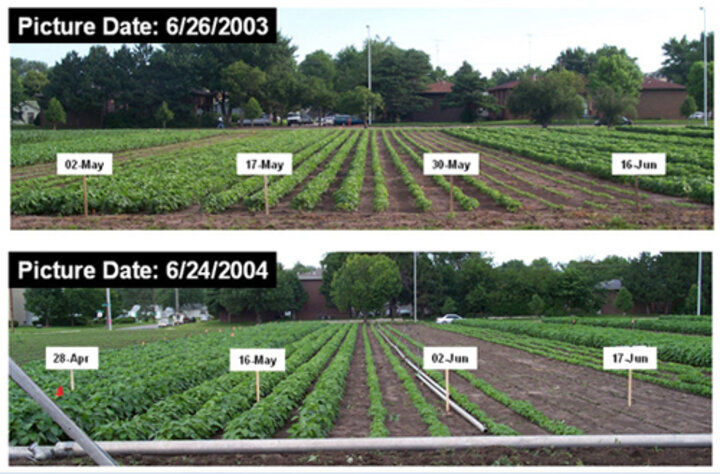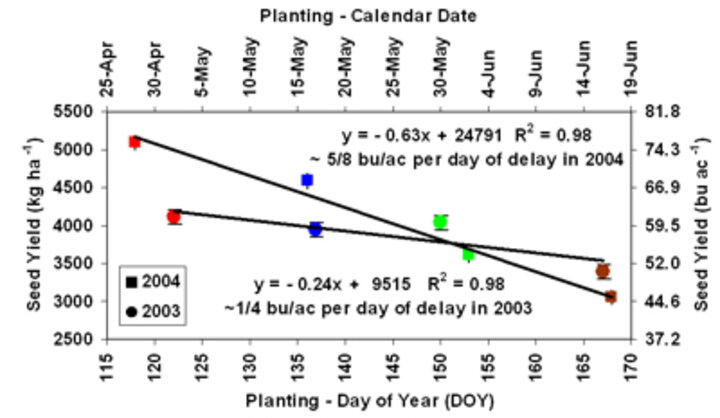April 10, 2009 When producers are asked the question "When do you plant your soybeans?", the typical response is "After I plant my corn!". (See box below). However, recent UNL small plot and on-farm research results show that Nebraska producers can benefit from planting their soybeans earlier. In fact, this research has shown there's a yield and a financial penalty associated with planting later.
A Look Behind the Article Nebraska soybean producers may have seen recent newspaper articles about a paper published in the Agronomy Journal. In that paper, the authors claim that there is no yield advantage to planting soybeans earlier than very late May in the Midwest. I and many of my research-extension colleagues in other Midwestern states have read that paper, and we disagree with the methods used to reach this conclusion.Most of the planting date and yield data used in that paper are from studies conducted 18 to 48 years ago. Moreover, in my scientific opinion, the relativization technique used by the authors to correct for the mean yield differentials in that old regionally sparse data is intrinsically flawed. Finally, the authors arbitrarily excluded several data sets and, more importantly, elected not to include in their analyses any of the recent planting date data from researchers in Nebraska, Iowa, Indiana, and Wisconsin that show higher yields arising from earlier planting dates. I have concluded, based on my research, that soybeans planted in early May will almost invariably deliver higher yields. However, you need not trust me, participate in some collaborative on-farm research conducted in your location or county to help you ultimately determine what is best for you. Jim Specht |
||||||||||||||||||||||||||||||||||||||||||||||||||||||||||||||||||||||||||||||||||||

|
||||||||||||||||||||||||||||||||||||||||||||||||||||||||||||||||||||||||||||||||||||
| Figure 1. Soybean strips that were planted (see plot signs) in early May (or late April), mid-May, late May (or early June), or late June in 2003 and 2004 on the UNL East Campus. The photos were taken in both years just a few days after the longest day of the year. You can see that the earlier the soybean planting, the earlier (in the year) canopy closure occurs. (Links to larger image.
|
||||||||||||||||||||||||||||||||||||||||||||||||||||||||||||||||||||||||||||||||||||

|
||||||||||||||||||||||||||||||||||||||||||||||||||||||||||||||||||||||||||||||||||||
| Figure 2. The UNL soybean planting date research shows that yield reduces linearly with planting date. (Links to larger version.) | ||||||||||||||||||||||||||||||||||||||||||||||||||||||||||||||||||||||||||||||||||||
|
||||||||||||||||||||||||||||||||||||||||||||||||||||||||||||||||||||||||||||||||||||
Nebraska Soybean Planting Date Research
UNL research funded by the Nebraska Soybean Board showed that when you delay soybean planting until after May 1, crop yield will decline. That yield decline can range from about one-quarter (0.25) bu/ac to about 5/8 (0.625) bu/ac depending on the year for each day you delay planting after May 1.
So, if you plant on May 16 instead of May 1, your soybean yield potential could decline by as little as 4 bu/ac (16 days x 0.25) or as much as 10 bu/ac (16 x 0.625). Multiply these potential loss numbers by the current market price of soybeans and you can easily how this could add up to a substantive loss in potential gross revenue. Figure 2 shows that the loss in yield is linear over planting dates.
As a producer you'll want to ensure that your soybean crop collects all of the sunlight it can as soon as it can. Sunlight is the energy the plant uses to reduce the carbon in CO2 into the carbon the plant uses to make carbohydrate, protein, and oil. Our goal is to plant early enough to have the crop look "all green to the eye by the 4th of July" (i.e., canopy intercepts all light, so no light falls on the ground and the closed canopy also minimizes soil water evaporation).
Aside from early planting resulting in more light capture and less soil water evaporation, we also discovered in our research that soybean plants add one new main stem node every 3.7 days after the first trifoliolate appears until seed development begins. A node is where the flowers, then pods, and then seeds in those pods are produced. It's to your advantage to provide the crop enough seasonal time to produce as many main stem nodes as possible. By delaying planting by one week (seven days), your crop just lost an opportunity to have two nodes on its main stem.
Nebraska Farmer Research Supports Early Soybean Planting
After learning about Dr. Specht's research, Greater Quad County on-farm research producers were curious how early planting dates would work on their farms in 2008. The cold, wet spring was a challenge as it was hard enough getting corn in at a decent time last year. But we still had three producers and the South Central Ag Lab near Clay Center conduct the planting date study for our area. All early planting dates were between April 23 and April 30 while the late planting dates ranged from May 14-May 19.
At all sites in 2008, the early planting date out-yielded the later one. At two locations (six total replications), a combination of the early/late study in addition to planting rates of 90K, 120K, 150K, and 180K were conducted. Average early planting yield was 1.8 bu/acre better than the late planted soybeans. Two other locations (containing a total of 15 replications) were planted at 150K with the early planting yielding 3.5 bu better than the later date.
All our on-farm research trials were conducted on 30-inch rows. Both the early and late planted beans were treated with a combination of fungicide and insecticide seed treatments to prevent problems with seedling diseases and bean leaf beetles on the early planted soybeans. These producers plan to repeat this study in 2009.
Be Aware of Your Frost Date
We realize there is concern for frost with early planted soybeans. It's important for you to know the probability for the last spring freeze in your location and determine the amount of risk you're willing to take. If your risk level is 0, then you can still plant a few days prior to that last spring freeze date as the seedlings will not be up and exposed to freezing air temperatures prior to that date.
A broad recommendation is for the southern two-thirds of Nebraska to plant the last week of April and the northern third plant the first week of May. Palle Pederson, ISU Extension Soybean Specialist, recommends the same planting dates for Iowa, based on his research findings. Based on our research, when thinking about soybean planting in 2009, think early because planting date truly does matter for soybeans in Nebraska.
For help in determining the spring freeze probability for your area, go to the High Plains Regional Climate Center site at http://www.hprcc.unl.edu. Click on Historical Data Summaries. Then click on the red dot representing the weather station closest to your farm. On the left-hand side, find the section titled Temperature and click on Spring Freeze Probabilities. If you'd prefer viewing this information as a table rather than a graph, click on Tabular Output.
Consider the following factors when using this data to estimate your risk of frost:
- Air temperatures close to the soil surface are somewhat warmer than higher air temperatures due to the boundary layer effect.
- It is the number of hours below freezing (32F) plus the type of exposed tissue that determines the degree of crop freezing injury. Just-emerged seedlings still in the cotyledon stage are less likely to be injured than are seedlings that already have unifoliolates or 1st trifoliolates.
- Temperatures are typically lowest just before dawn. Most producers should use the 28.5°F temperature graph line (or table row) as guideline, and then select the degree of risk (10% or 20%) to determine when that temperature might last occur in a given spring.
- The zero probability date is simply the historical month and day of the year in which the latest ever spring freeze occurred. Most producers should use the 10% probability date, because the last historical spring freeze date may be an outlier.
On-Farm Research Contacts
To learn more about on-farm research, contact one of the Extension educators listed in this related article or visit UNL’s On Farm Research Web site at http://farmresearch.unl.edu. The site includes research results, program descriptions, and information on designing your on-farm research comparison.
Jennifer Rees
Extension Educator in Clay County
Jim Specht
Professor, Department of Agronomy and Horticulture
